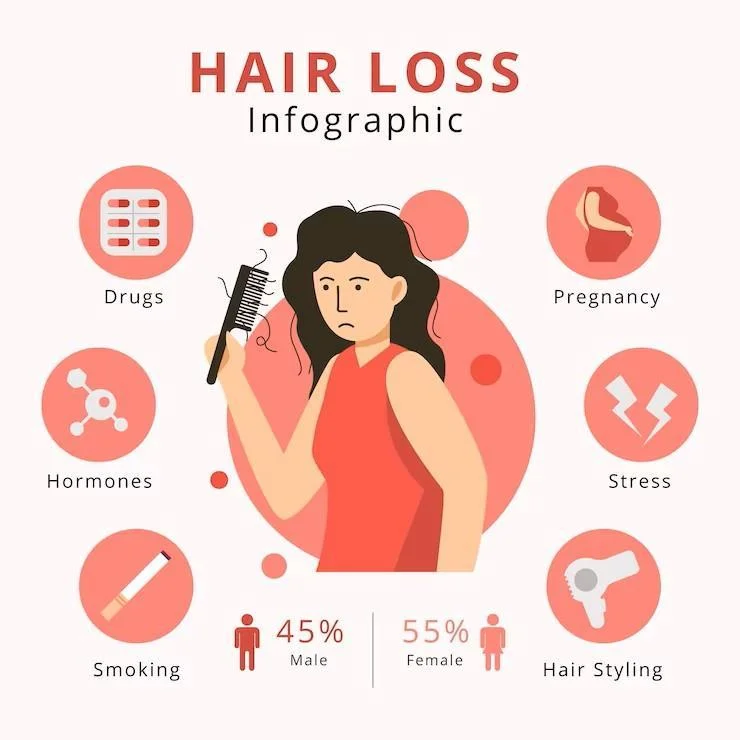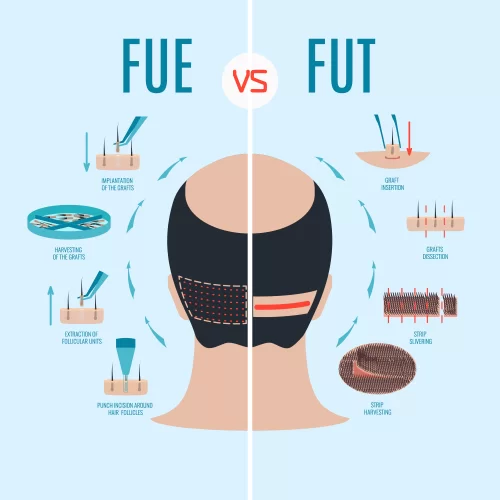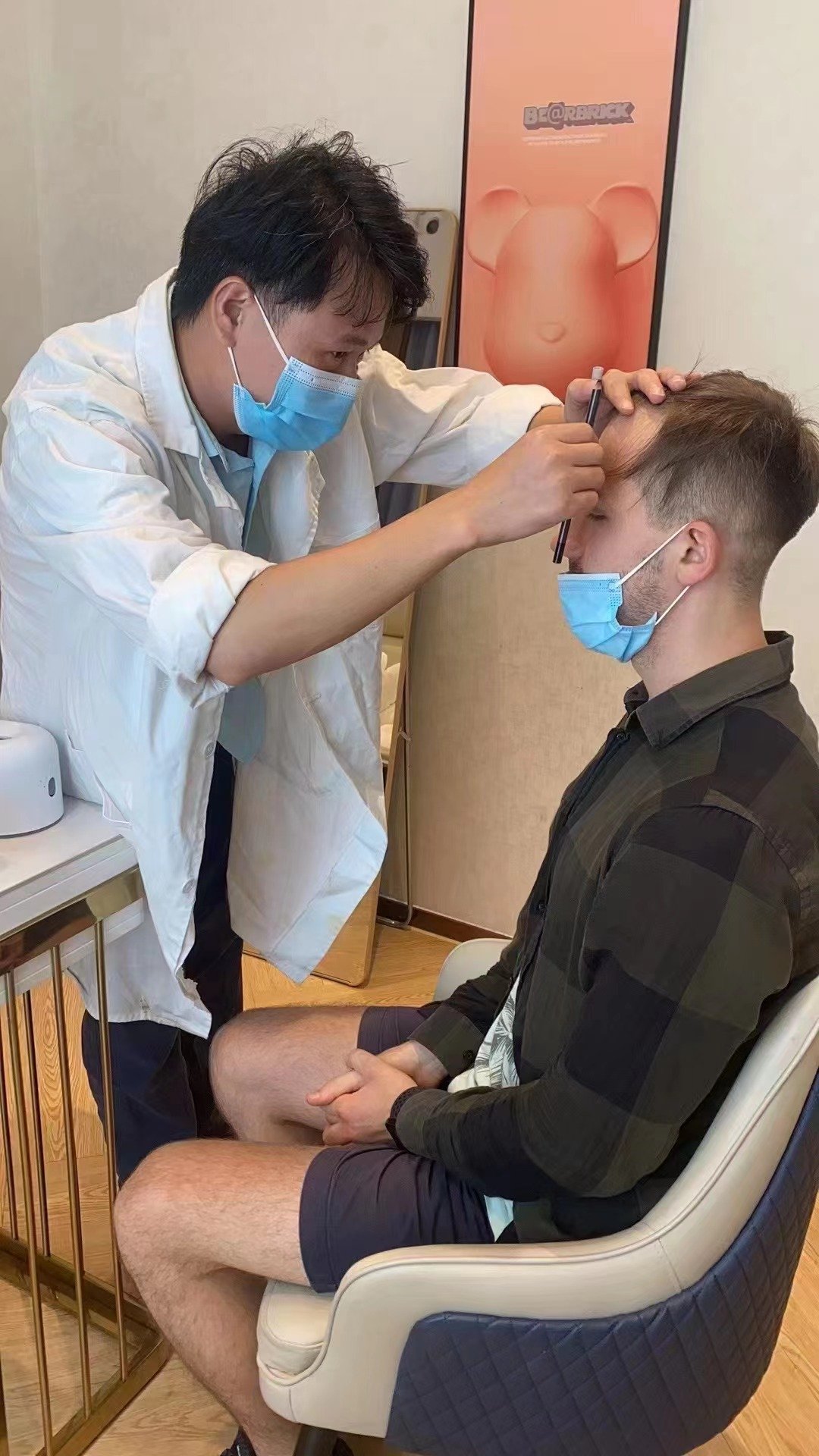Rediscover Your Confidence with Hair Transplant Solutions
Restore thicker, fuller hair and revitalize your self-assurance with our cutting-edge hair transplant procedures. Explore our personalized solutions today.
What is a hair transplant?
A hair transplant is a medical procedure that involves relocating individual hair follicles from one part of the body, called the ‘donor site’, to bald or balding parts of the body known as the ‘recipient site’. Typically used to treat male pattern baldness, hair transplants are increasingly popular among individuals looking to restore hair due to various types of alopecia or hair thinning. This procedure is performed under local anesthesia and can offer a permanent solution to hair loss.
What causes hair loss?
Hair loss can arise from various factors, ranging from genetic predispositions to lifestyle impacts. Below are the primary causes:
- Genetic Factors: Androgenetic alopecia, also known as male or female pattern baldness, is a hereditary condition causing predictable hair loss patterns—receding hairlines in men and thinning crowns in women.
- Hormonal Changes: Changes such as pregnancy, menopause, or thyroid issues can trigger hair loss. Conditions like polycystic ovary syndrome (PCOS) are also linked to hair thinning.
- Medical Conditions: Hair loss can stem from scalp infections like ringworm or autoimmune diseases like alopecia areata, where the immune system attacks hair follicles.
- Medications: Certain medications for cancer, arthritis, depression, and other conditions may have hair loss as a side effect.
- Nutritional Deficiencies: Lacking essential nutrients such as iron, vitamin D, and protein can lead to hair shedding and thinning.
- Stress: Physical or emotional stress can induce a temporary hair loss condition known as telogen effluvium, where hair follicles prematurely enter a resting phase.
- Hairstyling Practices: Over-styling or harsh treatments like tight braids and strong chemicals can cause traction alopecia, resulting in hair thinning and loss.
Understanding these causes is crucial in addressing hair loss effectively. At YD Beauty Surgery Hospital, we tailor treatments to combat these specific causes and restore hair health.

Stages of Male Hair Loss
Stage 1: Minimal Loss
Stage 2: Noticeable Recession
Stage 3: Visible Thinning
Stage 4: Significant Hair Loss

Understanding Hair Transplant
Follicular Unit Extraction (FUE)
This technique involves extracting individual hair follicles directly from the scalp without removing a strip of tissue. Each follicular unit contains 1 to 4 hairs and is extracted with a tiny punch typically ranging from 0.6mm to 1.0mm in diameter. The primary advantages of FUE include minimal scarring and a shorter recovery time, making it a preferred choice for those who wear their hair short.
Follicular Unit Transplantation (FUT)
Also known as strip surgery, this method involves removing a strip of scalp from the donor area which is then dissected into individual follicular units. While FUT can leave a linear scar, it allows for the transplantation of a larger number of grafts in one session and is often recommended for patients requiring substantial coverage.
The Procedure

Consultation

Hair Transplantation

Recovery

Follow-Up
Why Choose YD Beauty Surgery Hospital?
Expertise & Cutting-Edge Technology
At YD Beauty, we utilize state-of-the-art technology like the NeoGraft and AccuGraft systems for hair transplants. These tools enhance the accuracy of follicle extraction and placement, ensuring seamless integration of the transplanted hair with your natural growth pattern.
Experienced Medical Team
Our surgeons are not just medical professionals; they are artists who understand the aesthetics of hair growth. With years of specialized experience, they ensure that your new hairline looks natural and complements your facial features.

YD Beauty Hair Transplant : Before and After Gallery
Explore the impactful results of our Hair Transplant procedures through our Before and After Gallery. This section showcases real transformations of our previous patients, offering a visual testament to the precision and effectiveness of our treatments.






Risks and Considerations
Potential Risks and Complications
We believe in transparency. Like all surgical procedures, hair transplants come with potential risks, which include infection, scarring, and graft failure. However, our meticulous planning and advanced techniques significantly minimize these risks.
How Risks are Minimized at YD Beauty Hospital
At YD Beauty Hospital, ensuring patient safety is our foremost concern throughout every hair transplant procedure. We employ advanced surgical techniques and uphold stringent standards and protocols to guarantee the utmost safety and effectiveness. From comprehensive pre-surgical screenings to meticulous post-operative care, we prioritize risk reduction and optimal recovery.
Our commitment to transparent communication ensures that patients are fully informed about every facet of the procedure, from candidacy assessments to recovery expectations, resulting in maximum satisfaction and minimized risks.
Frequently Asked Questions about Hair Transplant
Get answers to the most common queries about Hair Transplant at YD Beauty Surgery. Our FAQs are here to help you make an informed decision and prepare for your transformation journey with confidence.
Is hair transplant surgery painful?
While discomfort during the procedure is minimized with local anesthesia, patients may experience some soreness or mild discomfort post-operatively. However, pain is typically manageable with prescribed medications.
How long does it take to see results after a hair transplant?
Hair growth following a transplant is gradual, with initial results becoming visible within 3 to 6 months. Full results, including thicker and denser hair, can be appreciated within 12 to 18 months post-procedure.
Are hair transplant results permanent?
Yes, hair transplant results are considered permanent as transplanted hair follicles are resistant to the hormone responsible for hair loss. However, it’s essential to maintain overall scalp health and follow post-operative care instructions to optimize long-term results.
Will I have noticeable scars after a hair transplant?
With modern techniques like Follicular Unit Extraction (FUE), scarring is minimal and often undetectable. Tiny puncture wounds heal quickly, leaving tiny dot-like scars that are easily concealed by surrounding hair.
Am I a suitable candidate for a hair transplant?
Ideal candidates for hair transplant surgery have sufficient donor hair, good overall health, and realistic expectations. During a consultation, our specialists will assess your candidacy based on these factors and recommend the most suitable treatment plan.
Can I undergo multiple hair transplant procedures?
Yes, multiple hair transplant procedures can be performed to achieve desired hair density and coverage, especially for individuals with advanced hair loss or those seeking additional enhancement.
How long is the recovery period after a hair transplant?
Recovery time varies among individuals but typically ranges from 7 to 10 days. Patients can resume non-strenuous activities shortly after the procedure, with full recovery and hair growth progression over several months.
Are there any risks or complications associated with hair transplant surgery?
While hair transplant surgery is generally safe, like any surgical procedure, it carries some risks, including infection, bleeding, swelling, and scarring. Our experienced medical team takes comprehensive measures to minimize these risks and ensure a smooth recovery process for every patient.
Get a consultation now!
We believe in building lifelong relationships with our clients. We believe in serving clients with responsibility, professionalism and honesty.


